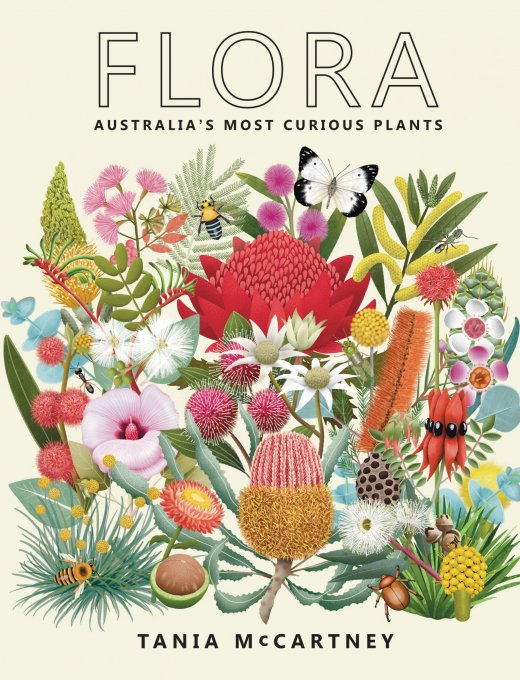
Tania McCartney’s Flora features deadly and beautiful Australian plants. Images: Supplied.
Who would have thought that the Australian bush and suburban gardens could be harbouring so many deadly plants? Tania McCartney’s Flora (National Library of Australia Publishing, 2024) will open your eyes to the vast wonders of our Australian plants, the deadly and the beautiful, and sometimes both at once.
The book sits as a worthy companion to her Fauna (NLA, 2019) and is thoroughly researched, colourfully illustrated and designed to appeal to upper primary and early secondary readers.
The overarching messages of the book are that Australia is home to extraordinary and unusual plants and that we can all play a part in their conservation.
The language is sophisticated, respectfully acknowledging the intelligence and learning capacities of its young readers. While the author is intent on providing scientific facts, she does this in a chatty style, inviting young, potential backyard botanists to marvel at so much that is on their doorsteps.
Tania’s detailed and numerous illustrations add to its accessibility, and a comprehensive glossary and index aid seekers of specific knowledge.
Altogether, this is an impressive work by an author-artist who demonstrates her passion for the subject and her educative zeal in both the quality of her research and the care with which she has chosen what to impart.

Steve Matthews’ Perversion of Justice is a crime fiction about false accusations and unjust arrests.
Dangerous types of a different kind are the focus of Steve Matthews’ Perversion of Justice (Big Sky Publishing, 2024; cover and internal design Think Productions).
Departing from his historical fiction focusing on the Nazi era, Matthews moves to a case of false accusation and unjust arrest. He remains, however, deeply interested in justice, in the workings of the human psyche and in relationships, both positive and toxic.
The Fullwood family is at the centre of the story. They are of Jamaican origin but are long-time residents and citizens of Sydney. There are three brothers, and it is Percy, a pillar of the church and doer of much good work in society, who falls victim to the accusations of younger brother Leroy that he has molested his adolescent nephew and niece.
Enter our heroine crime solver, Diane Spencer, whose fortuitous marriage has led to untold wealth. Her brother Bruce is, coincidentally, the police officer in charge of the Percy Fullwood investigation. It is also serendipitous that Diane’s brief but lucrative marriage to a high-tech geek has given her insight into the workings of information storage and secretion – a matter that comes up when evidence is buried.
Diane is not content to spend her life simply shopping for designer wear and she founds an organisation called the Social Injustice Centre (SIC, also a wry play by the author on the Latin abbreviation which points to an inherent error). She doggedly pursues the Fullwood case when she happens upon some evidence on a flash drive inadvertently left at her apartment by her brother. She twigs that not all is right with the case, determines to see justice done, and calls upon a canny lawyer friend to help.
This is inevitably a story full of nefarious types and much nastiness. There are sleazy characters, corrupt police and politicians and a prurient, sensationalist press out for headline-grabbing stories. The institution of the church also comes under fire for its venality. Money, of course, is the root of all (or most) evil in this plot, as it commonly is in crime fiction.
In the end, while we travel through the mire in this story, we are left with a clear consciousness of Steve Matthews’ ongoing interest in human nature and how it can be better. There is more than a passing nod to the forces that mould personality and, hence, determine human interactions. A compassionate interest in human psychology remains a forceful driver for this author’s work, no matter the genre.
This is the first of a series of four Social Injustice Centre books.
Barbie Robinson is co-founder and a content creator for Living Arts Canberra, a not-for-profit media outfit supporting arts and community in the Canberra region and books worldwide through its website, podcast interviews and a 24/7 internet radio station at Living Arts Canberra.














